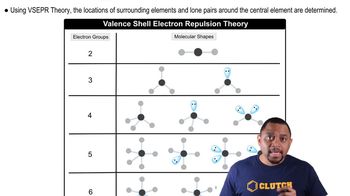Determine the electron geometry, molecular geometry, and idealized bond angles for each molecule. In which cases do you expect deviations from the idealized bond angle? a. PF3 b. SBr2 c. CHCl3 d. CS2
Ch.10 - Chemical Bonding II: Molecular Shapes & Valence Bond Theory
All textbooks Tro 4th Edition
Tro 4th Edition Ch.10 - Chemical Bonding II: Molecular Shapes & Valence Bond Theory
Ch.10 - Chemical Bonding II: Molecular Shapes & Valence Bond Theory Problem 38
Problem 38
 Tro 4th Edition
Tro 4th Edition Ch.10 - Chemical Bonding II: Molecular Shapes & Valence Bond Theory
Ch.10 - Chemical Bonding II: Molecular Shapes & Valence Bond Theory Problem 38
Problem 38Chapter 10, Problem 38
Which species has the smaller bond angle, ClO4- or ClO3- ? Explain.
 Verified step by step guidance
Verified step by step guidance1
Identify the central atom in each species: ClO4^- and ClO3^- both have chlorine (Cl) as the central atom.
Determine the number of electron domains around the central atom: ClO4^- has four oxygen atoms bonded to Cl, while ClO3^- has three oxygen atoms and one lone pair on Cl.
Use VSEPR theory to predict the molecular geometry: ClO4^- has a tetrahedral geometry, while ClO3^- has a trigonal pyramidal geometry due to the lone pair.
Recall that lone pairs repel more strongly than bonding pairs, causing bond angles to decrease in the presence of lone pairs.
Conclude that ClO3^- has a smaller bond angle than ClO4^- because the lone pair on ClO3^- causes greater repulsion, reducing the bond angle compared to the tetrahedral angle in ClO4^- which has no lone pairs.

Verified Solution
Video duration:
2mWas this helpful?
Key Concepts
Here are the essential concepts you must grasp in order to answer the question correctly.
VSEPR Theory
Valence Shell Electron Pair Repulsion (VSEPR) Theory is a model used to predict the geometry of molecules based on the repulsion between electron pairs around a central atom. According to this theory, electron pairs, whether bonding or non-bonding, will arrange themselves to minimize repulsion, which directly influences bond angles.
Recommended video:
Guided course

Molecular Shapes and VSEPR
Resonance Structures
Resonance structures are different ways of drawing the same molecule that show the delocalization of electrons. In the case of ClO3- and ClO4-, resonance can affect the distribution of electron density and the overall geometry, which in turn influences the bond angles between the chlorine and oxygen atoms.
Recommended video:
Guided course

Resonance Structures
Hybridization
Hybridization is the concept of mixing atomic orbitals to form new hybrid orbitals that can accommodate bonding. The hybridization state of the central atom, chlorine in this case, determines the geometry and bond angles of the molecule. ClO4- is typically sp3 hybridized, while ClO3- can exhibit sp2 hybridization, leading to different bond angles.
Recommended video:
Guided course

Hybridization
Related Practice
Textbook Question
1624
views
1
comments
Textbook Question
Determine the electron geometry, molecular geometry, and idealized bond angles for each molecule. In which cases do you expect deviations from the idealized bond angle? a. CF4 b. NF3 c. OF2 d. H2S
1172
views
Textbook Question
Which species has the smaller bond angle, H3O+ or H2O? Explain.
1068
views
Open Question
Determine the molecular geometry and sketch each molecule or ion using the bond conventions shown in “Representing Molecular Geometries on Paper” in Section 10.4 for the following: a. SF4 b. ClF3.
Textbook Question
Determine the molecular geometry and sketch each molecule or ion using the bond conventions shown in 'Representing Molecular Geometries on Paper' in Section 10.4. c. IF2-
468
views
Textbook Question
Determine the molecular geometry and sketch each molecule or ion using the bond conventions shown in 'Representing Molecular Geometries on Paper' in Section 10.4. d. IBr4-
778
views